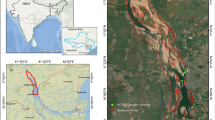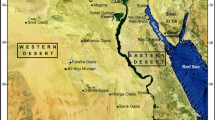Abstract
A novel water extraction method is proposed to improve the ability of delineation of the narrow water for the modified normalized difference water index (MNDWI) derived from remotely sensed images. This method introduces a morphological white top-hat transforming operation on the MNDWI to construct a morphological narrow water index (MNWI). The MNWI can effectively enhance the local contrast of linear objects, such that the narrow water can be easily separated from mountain shadows, bare patches and other land covers in the MNDWI image. Furthermore, a dual-threshold segmentation method was also used to extract the potential water bodies by combining an empirical threshold segmentation on the MNDWI and an automatic threshold segmentation on the MNWI. The effectiveness of the proposed method was validated with three experimental datasets, clipped from two different Landsat images, and the results demonstrate that the narrow water bodies can be effectively extracted with the overall accuracy being over 90%. Visually, most of the narrow streams or rivers keep continuous shapes in space and their water boundaries are also precisely delineated.









Similar content being viewed by others
References
Beneditsson, J. A., Pesaresi, M., & Arnason, K. (2003). Classification and feature extraction for remote sensing images from urban area based on morphological transformations. IEEE Transaction on geosciences and remote sensing, 41(9), 1940–1949.
Carleer, A. P., & Wolff, E. (2006). Urban land cover multi-level region-based classification of VHR data by selecting relevant features. International Journal of Remote Sensing, 27(6), 1035–1051.
Frazier, P. S., & Page, K. J. (2000). Water body detection and delineation with Landsat TM data. Photogrammetric Engineering and Remote Sensing, 66, 1461–1468.
Huang, X., & Zhang, L. (2011). A multidirectional and multi-scale morphological index for automatic building extraction from multispectral GeoEye-1 imagery. Photogrammetric Engineering & Remote Sensing, 77(7), 721–732.
Huang, X., Zhang, L., & Wang, L. (2009). Evaluation of morphological texture features for mangrove forest mapping and species discrimination using multispectral IKONOS imagery. IEEE Geoscience and Remote Sensing Letters, 6(3), 393–397.
Ji, L., Zhang, L., & Wylie, B. (2009). Analysis of dynamic thresholds for the Normalized Difference Water Index. Photogrammetric Engineering and Remote Sensing, 75(11), 1307–1317.
Jiang, H., Feng, M., & Zhu, Y. (2014). An automated method for extracting rivers and lakes from Landsat imagery. Remote Sensing, 6(6), 5067–5089.
Li, W., Du, Z., Ling, F., et al. (2013). A comparison of land surface water mapping using the normalized difference water index from TM, ETM + and ALI. Remote Sensing, 5, 5530–5549.
Li, Y., Ding, J., & Yan, R. (2015). Study on extraction method of small water bodies in mountainous area based on GF-1 remote sensing images. Resource Science, 37(2), 408–416. (in Chinese with English abstract).
McFeeters, S. (1996). The use of the Normalized Difference Water Index (NDWI) in the delineation of open water features. International Journal of Remote Sensing, 17, 1425–1432.
Otsu, N. (1979). A threshold selection method from gray-level histograms. IEEE Transactions on Systems, Man and Cybernetics, 9(1), 62–66.
Rundquist, D. C., Lawson, M. P., Queen, L. P., & Cerveny, R. S. (1987). The relationship between summer-season rainfall events and lake-surface area. Journal of the American Water Resources Association, 23, 493–508.
Wu, B., Fang, C., Yu, L., Huang, X., & Zhang, Q. (2016). A fully automatic method to extract rare earth mining area from Landsat Image. Photogrammetric Engineering and Remote Sensing, 82(9), 55–64.
Xu, H. (2006). Modification of normalised difference water index (NDWI) to enhance open water features in remotely sensed imagery. International Journal of Remote Sensing, 27, 3025–3033.
Yang, S., Xue, S., & Liu, T. (2010). Method for automatically extracting fine water body by using TM image. Journal of Surveying and mapping, 39(6), 611–617. (in Chinese with English abstract).
Zha, Y., Gao, Y., & Ni, S. (2003). Use of normalized Difference Built-Up Index in automatically mapping urban areas from TM imagery. International Journal of Remote Sensing, 24(3), 583–594.
Acknowledgements
Funding was provided by the Natural Science Foundation of China (Grant No. 41571330) and funded by Fundamental Research Funds for the Central Universities (Grant No. 2015XKMS050).
Author information
Authors and Affiliations
Corresponding author
About this article
Cite this article
Wu, B., Zhang, J. & Zhao, Y. A Novel Method to Extract Narrow Water Using a Top-Hat White Transform Enhancement Technique. J Indian Soc Remote Sens 47, 391–400 (2019). https://doi.org/10.1007/s12524-018-0910-z
Received:
Accepted:
Published:
Issue Date:
DOI: https://doi.org/10.1007/s12524-018-0910-z




